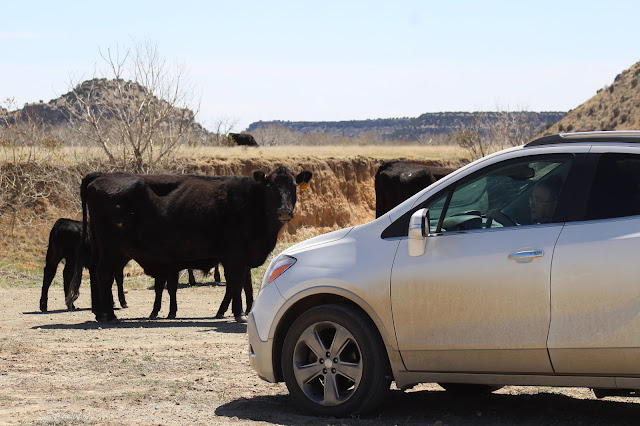Up with the alarm at 5 a.m. and made it
over to the “Main House” for breakfast at 6:30, when the folks that were
staying at the Hoot Owl Ranch arrived.
Jane Apple serves up a fine breakfast, and plenty of robust coffee. This place appears to subscribe to the axiom
that my father touted, that: “Most people camp too close to the creek to make
good coffee…”
Our first birding was through the village of Kenton, where one of the birders had seen a Red Crossbill earlier that morning. We spent a lot of time at the town’s feeders (both of them), but didn’t see that species, although Say’s Phoebes were ubiquitous.
Our first birding was through the village of Kenton, where one of the birders had seen a Red Crossbill earlier that morning. We spent a lot of time at the town’s feeders (both of them), but didn’t see that species, although Say’s Phoebes were ubiquitous.
The declining
fortunes of the town were evident in the empty buildings,
but the town’s spirit
remains intact.
 |
| This empty building had a beautiful Wood Duck stained glass window |
 |
| This one didn't have a window . . . |
 |
| Jon and Gail seated at the closed Mercantile . . . |
 |
| Cimarron River Bridge |
 While I’m used to
seeing magpies Back West in eastern Washington, they were a draw for the
East-Coasters in the group.
While I’m used to
seeing magpies Back West in eastern Washington, they were a draw for the
East-Coasters in the group. |
| Scoping the 'pie |
 |
| Did I mention that Say's Phoebes are ubiquitous? |
 We left then for Black Mesa State Park,
where we drove in and walked through the campground, then checked out Lake Carl
Etling.
We left then for Black Mesa State Park,
where we drove in and walked through the campground, then checked out Lake Carl
Etling. |
| Birding is just a "day in the Park" |
 |
| Canyon Wren |
 |
| Getting that "twitch" |
 |
| Cow-Calf Operation |
 |
| A little bull calf |
 These tracks have been preserved in a
sandstone stratum next to Carrizo Creek.
This trackway was originally discovered in the 1980s, and contained 47
footprints. Due to subsequent erosion,
only a third of those tracks are visible today.
Today they were covered with mud from last week’s rains, but were
readily discernible.
These tracks have been preserved in a
sandstone stratum next to Carrizo Creek.
This trackway was originally discovered in the 1980s, and contained 47
footprints. Due to subsequent erosion,
only a third of those tracks are visible today.
Today they were covered with mud from last week’s rains, but were
readily discernible. Scientists were intrigued by two tracks
in particular that were much deeper than the others and had a ridge. They postulated that the dinosaur was walking
on a mudflat area and slipped, leaving a telltale sign that has lasted for
millions of years. Although the exact
species is not known, the palaeontologists believe the tracks came from a
theropod, which is a scientific classification for bipedal carnivorous
dinosaurs, such as Tyrannosaurus rex.
Scientists were intrigued by two tracks
in particular that were much deeper than the others and had a ridge. They postulated that the dinosaur was walking
on a mudflat area and slipped, leaving a telltale sign that has lasted for
millions of years. Although the exact
species is not known, the palaeontologists believe the tracks came from a
theropod, which is a scientific classification for bipedal carnivorous
dinosaurs, such as Tyrannosaurus rex. |
| This track is about 16 inches wide |
 |
| Preston Tri-State Monument |
Jimmy just had to show us a sign erected by the owners of the Rainier Ranch, who graze their cattle on hundreds of acres of State Land, and wish to keep “Rabid Environmentalists” and other suspect types off the leased public land . . .
 |
| Regnier Ranch sign - correct spelling is optional |
 |
| Looking for a treat? |
 |
| Male Bushtits have dark eyes . . . |
 This evening before supper, we were
treated to a slide show by one of our birders, Bennett Pierce, which was well
received by the group. Tonight’s supper
back at the Hitching Post B&B was meat loaf, green bean casserole, cheese potatoes and dessert of cherry
scrabble, after which I returned to LeRoss’ place for a full night’s sleep.
This evening before supper, we were
treated to a slide show by one of our birders, Bennett Pierce, which was well
received by the group. Tonight’s supper
back at the Hitching Post B&B was meat loaf, green bean casserole, cheese potatoes and dessert of cherry
scrabble, after which I returned to LeRoss’ place for a full night’s sleep. |
| Daisy - Erigeron annuus |
Cimarron River eBird
Checklist is Here
Black Mesa State
Park eBird Checklist is Here
Easter Pageant Road eBird Checklist is Here
Hoot Owl Ranch eBird Checklist is Here




No comments:
Post a Comment